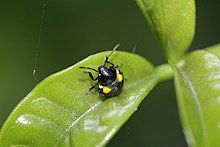Glaucias amyoti
| Glaucias amyoti | |
|---|---|

| |
| Scientific classification | |
| Domain: | Eukaryota |
| Kingdom: | Animalia |
| Phylum: | Arthropoda |
| Class: | Insecta |
| Order: | Hemiptera |
| Suborder: | Heteroptera |
| Family: | Pentatomidae |
| Genus: | Glaucias |
| Species: | G. amyoti
|
| Binomial name | |
| Glaucias amyoti (Dallas, 1851)
| |
| Synonyms | |
|
Rhaphigaster amyoti Dallas, 1851 | |



Glaucias amyoti, commonly called the Australasian green shield bug or New Zealand vegetable bug, is a species of shield bug found in Australia, New Zealand, Timor and New Guinea.[1]
Adults and juveniles feed off plants including certain Coprosma, Griselinia and Myoporum species.[2]
Description
According to the original description, adults of G. amyoti are ovate in shape and green in colour. The dorsal surface is densely punctate, while the ventral surface is paler and very finely punctate. The edges of the thorax, hemelytra and abdomen are paler than the rest. The hemelytral membranes are transparent. The disc of the underside is yellowish. The legs are green. The rostrum is testaceous (a dull orange or brownish colour) except for a black tip. The antennae are green. The body length is 7-8 lines, which is equivalent to about 15-17 mm.[3]
References
- ^ "Australasian green shield bug - Glaucias amyoti". Taranaki Educational Resource: Research, Analysis and Information Network. Archived from the original on 16 June 2012. Retrieved 3 October 2012.
- ^ "Australasian green shield bug - Glaucias amyoti". Landcare Research. Retrieved 3 October 2012.
- ^ British Museum (Natural History).; Dallas, W. S.; Gray, John Edward (1851). List of the specimens of hemipterous insects in the collection of the British Museum. London: Printed by order of the Trustees. doi:10.5962/bhl.title.20373.
